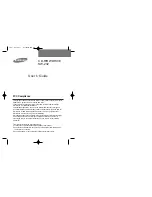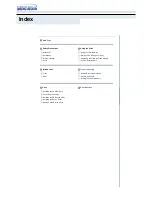
B-10
Creating Custom Motor Files
Peak Torque
The peak or maximum torque specifies the maximum current capability of the motor in peak Amps. (Note:
This is peak Amps, rather than rms.) The drive uses the maximum torque value to limit the current applied
to the motor. At run-time, the instantaneous current of the drive is limited to the
minimum
of this value,
the drive's peak rating, the analog current limit inputs, and the software current limits. The maximum
torque value can be in the range from 0.0078 to 255.9922 Amps.
Some manufacturers specify the maximum current of a motor in rms Amps. To convert from rms Amps
to peak Amps, use the formula:
Occasionally a manufacturer specifies only the maximum instantaneous torque, and does not include the
maximum current specification. In such a case, the peak current can be computed using the peak torque
and the torque constant. A factor of 1.1 is included to allow for degradation of the torque constant at high
temperatures, etc. The formula, assuming the torque constant has already been converted to N-m/A(peak),
is given by:
Thermal Time Constant
The thermal time constant check box indicates if a valid thermal time constant exists for the motor. If this
check box is not selected, the motor thermal protection software is disabled.
Enabling of the motor thermal protection software is recommended, even if the thermal time constant is
not known. This software feature significantly reduces the chance of damage to the motor, even when the
motor has an integral thermostat.
The thermal time constant value, also known as the cool down time constant, identifies how fast the motor
winding temperature dissipates heat. The value is entered in seconds. The thermal time constant value
can be in the range from 1 to 65535 seconds.
The thermal time constant of the motor is measured by stabilizing the motor temperature at its rated
condition, disabling the drive, and measuring the time for the hottest part of the motor winding to drop
63% of the difference from ambient. Thomson Industries, as well as many other motor manufacturers,
specifies this parameter for motors, although it may not be published in catalogs or data sheets.
If the thermal time constant of a motor is unknown or unavailable, an estimated value is preferable to
disabling the motor thermal protection software. A reasonable substitute is to find an Thomson Industries
motor with similar capability, and use its thermal time constant value for the custom motor.
The motor thermal protection algorithm filters the square of the torque current (using the motor thermal
time constant value) and generates a motor thermal protection fault if the output of the filter exceeds the
square of the motor's continuous torque current rating. The square of the current is used because the power
dissipated in the motor is approximated as I2R losses. Figure D.6 shows the method to be used for
protection, with t defined as the motor thermal time constant.
Intro
F
IGURE
B.6
Motor Thermal Protection Software Method
1 Amps
Amps(rms)
⋅
=
⋅
1414
.
I
1.1
maximum torque in N m
K
PEAK
T
=
⋅
⋅
1
1+s
1
1+s
τ
+
-
Motor
Overcurrent
Fault
I
TORQUE
2
I
RATED
2
Artisan Technology Group - Quality Instrumentation ... Guaranteed | (888) 88-SOURCE | www.artisantg.com
















































